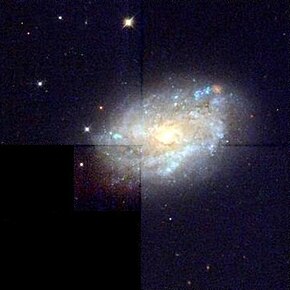| NGC 4790 | |
|---|---|
 NGC 4790 imaged by the Hubble Space Telescope | |
| Observation data (J2000 epoch) | |
| Constellation | Virgo |
| Right ascension | 12h 54m 51.956s[1] |
| Declination | −10° 14′ 52.2″[1] |
| Redshift | 0.004483[1] |
| Heliocentric radial velocity | 1344 ± 5 km/s[1] |
| Distance | 80.8 ± 5.8 Mly (24.76 ± 1.77 Mpc)[1] |
| Group or cluster | NGC 4699 Group |
| Apparent magnitude (V) | 12.4 |
| Characteristics | |
| Type | SB(rs)c?[1] |
| Size | ~45,500 ly (13.95 kpc) (estimated)[1] |
| Apparent size (V) | 1.55′ × 1.0′[1] |
| Other designations | |
| IRAS 12522-0958, MCG -02-33-056, PGC 43972[1] | |
NGC 4790 is a barred spiral galaxy located in the constellation of Virgo. Its velocity with respect to the cosmic microwave background is 1679 ± 24 km/s, which corresponds to a Hubble distance of 80.8 ± 5.8 Mly (24.76 ± 1.77 Mpc).[1] In addition, six non-redshift measurements give a distance of 74.75 ± 4.07 Mly (22.917 ± 1.249 Mpc).[2] It was discovered on 25 March 1786 by German-British astronomer William Herschel.[3]
NGC 4790 is a member of the NGC 4699 Group (also known as LGG 307) of galaxies, which is a member of the Virgo II Groups, a series of galaxies and galaxy clusters strung out from the southern edge of the Virgo Supercluster.[4][5]
One supernova has been observed in NGC 4790. SN 2012au (type Ib, mag. 13.8) was discovered by the Catalina Sky Survey on 14 March 2012.[6][7] This supernova later produced evidence of a pulsar wind nebula which appears to be expanding outward at approximately 2300 km/s. [8]
- ^ a b c d e f g h i j "Results for object NGC 4790". NASA/IPAC Extragalactic Database. NASA and Caltech. Retrieved 25 November 2024.
- ^ "Distance Results for NGC 4790". NASA/IPAC EXTRAGALACTIC DATABASE. NASA. Retrieved 25 November 2024.
- ^ Seligman, Courtney. "New General Catalogue Objects: NGC 4790". Celestial Atlas. Retrieved 25 November 2024.
- ^ "The Virgo III Groups". Atlas of the Universe. Retrieved 2010-11-27.
- ^ Garcia, A. M. (1993). "General study of group membership. II. Determination of nearby groups". Astronomy and Astrophysics Supplement Series. 100: 47. Bibcode:1993A&AS..100...47G.
- ^ "SN 2012au". Transient Name Server. IAU. Retrieved 25 November 2024.
- ^ SN 2012au at rochesterastronomy.com
- ^ Milisavljevic, Dan; Patnaude, Daniel J.; Chevalier, Roger A.; Raymond, John C.; Fesen, Robert A.; Margutti, Raffaella; Conner, Brody; Banovetz, John (2018). "Evidence for a Pulsar Wind Nebula in the Type Ib Peculiar Supernova SN 2012au". The Astrophysical Journal Letters. 864 (2): L36. arXiv:1809.01141. Bibcode:2018ApJ...864L..36M. doi:10.3847/2041-8213/aadd4e.